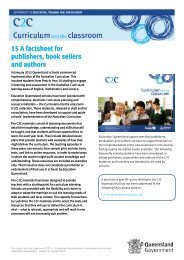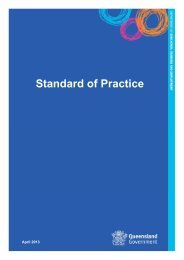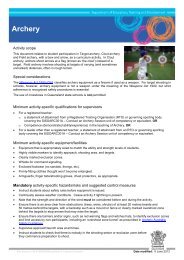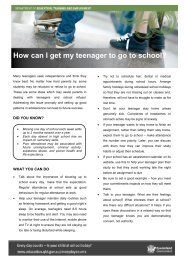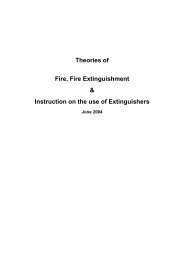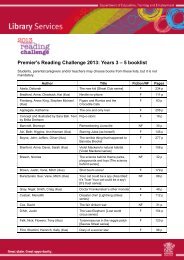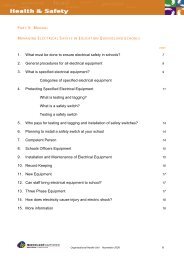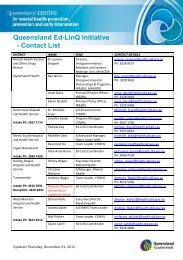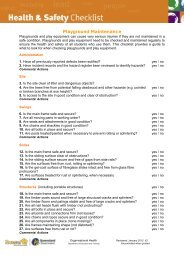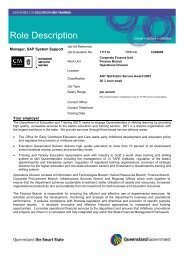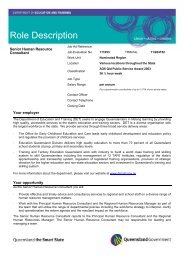Anaphylaxis guidelines for Queensland State Schools - Education ...
Anaphylaxis guidelines for Queensland State Schools - Education ...
Anaphylaxis guidelines for Queensland State Schools - Education ...
Create successful ePaper yourself
Turn your PDF publications into a flip-book with our unique Google optimized e-Paper software.
• Provide input in the development of the school’s <strong>Anaphylaxis</strong> Risk Management Plan to minimise risks<br />
of exposure <strong>for</strong> students when participating in activities you supervise.<br />
• Consider the risks associated with school activities such as cooking, art lessons, excursions and camps<br />
<strong>for</strong> students with anaphylaxis in accordance with the Managing risks in school curriculum Activities<br />
procedure.<br />
• Provide relevant in<strong>for</strong>mation to excursion/camp site coordinators (e.g. outdoor education centres) prior<br />
to the event to enable a risk assessment of activities and the environment to occur.<br />
• Be aware that craft items can be risk items (<strong>for</strong> example, egg cartons, milk containers, peanut butter<br />
jars).<br />
• Provide age-appropriate education to students regarding severe allergies. Age appropriate peer<br />
education is important in reducing the risk of exposure. Peers are also able to alert teaching staff if they<br />
see a student with a history of allergy looking unwell. (For useful resources, see<br />
http://www.allergyfacts.org.au/links/online-store).<br />
• Ensure all students are aware of the risks associated with anaphylaxis and the unacceptable dangers of<br />
teasing students with their allergic triggers.<br />
10. Roles and responsibilities of the first aid officer<br />
• Ensure the school adrenaline auto-injector is:<br />
- stored in a safe, cool, dark, unlocked location and is easily<br />
accessible<br />
- kept below 25 degrees Celsius if possible (as extreme<br />
temperatures may reduce shelf life) but not refrigerated as<br />
temperatures below 15 degrees Celsius may cause the injector<br />
mechanism to jam<br />
- available <strong>for</strong> use after hours <strong>for</strong> students who participate in<br />
extracurricular activities conducted by the school on the school<br />
grounds outside normal school hours, e.g. school disco<br />
- checked <strong>for</strong> maximum shelf life when the adrenaline autoinjector<br />
is being purchased <strong>for</strong> the school. The shelf life of an<br />
adrenaline auto-injector is normally around 1 to 2 years.<br />
First aid kit containing<br />
auto-injector with Action<br />
Plan (general)<br />
displayed<br />
• Regularly monitor, maintain and check expiry dates of the school<br />
adrenaline auto-injector.<br />
• Consider temperatures of storage areas during weekends and<br />
school holidays.<br />
Example of school first aid kit<br />
• Consider portable storage bags which maintain a steady<br />
temperature if a school adrenaline auto-injector is carried to events<br />
such as excursions, camps or sports events. NB. These storage<br />
bags are not eskies. Do not store auto-injectors in eskies with ice<br />
or icepacks.<br />
• Ensure students with anaphylaxis are not left alone when<br />
complaining of feeling unwell, even in the sickbay/sick room. Their<br />
complaint should be taken seriously.<br />
24 <strong>Anaphylaxis</strong> <strong>guidelines</strong> <strong>for</strong> <strong>Queensland</strong> state schools



